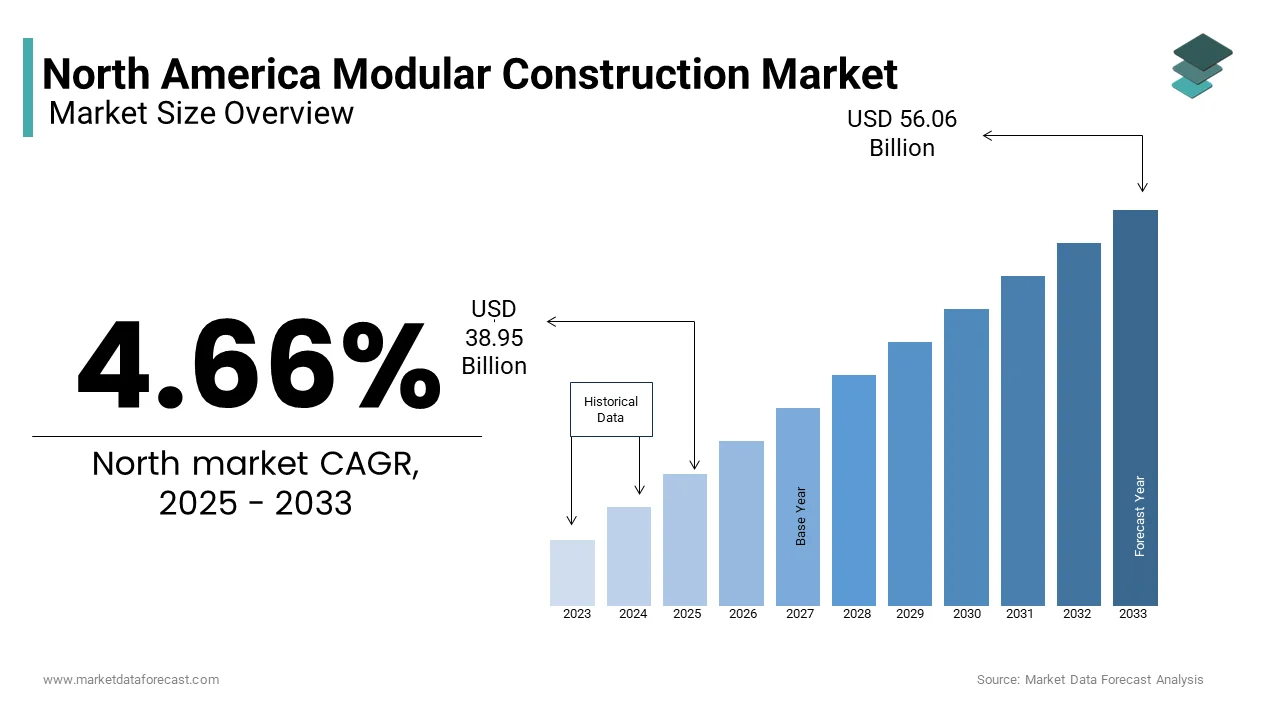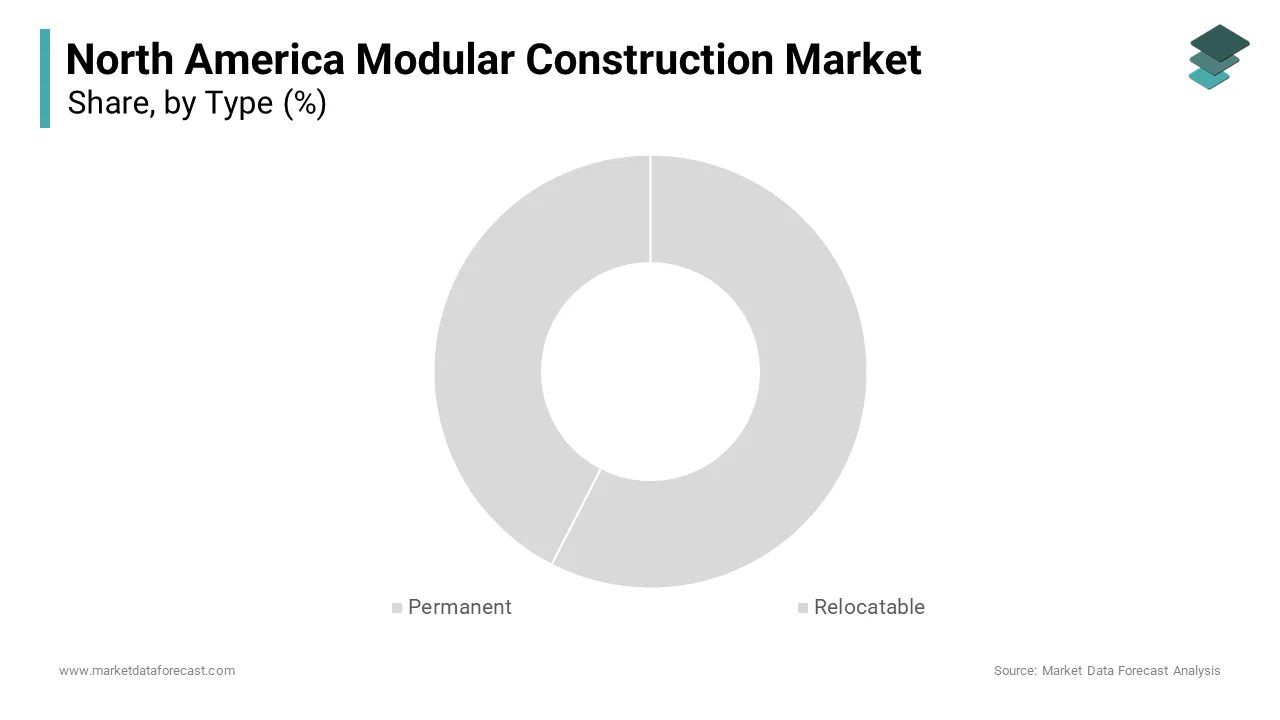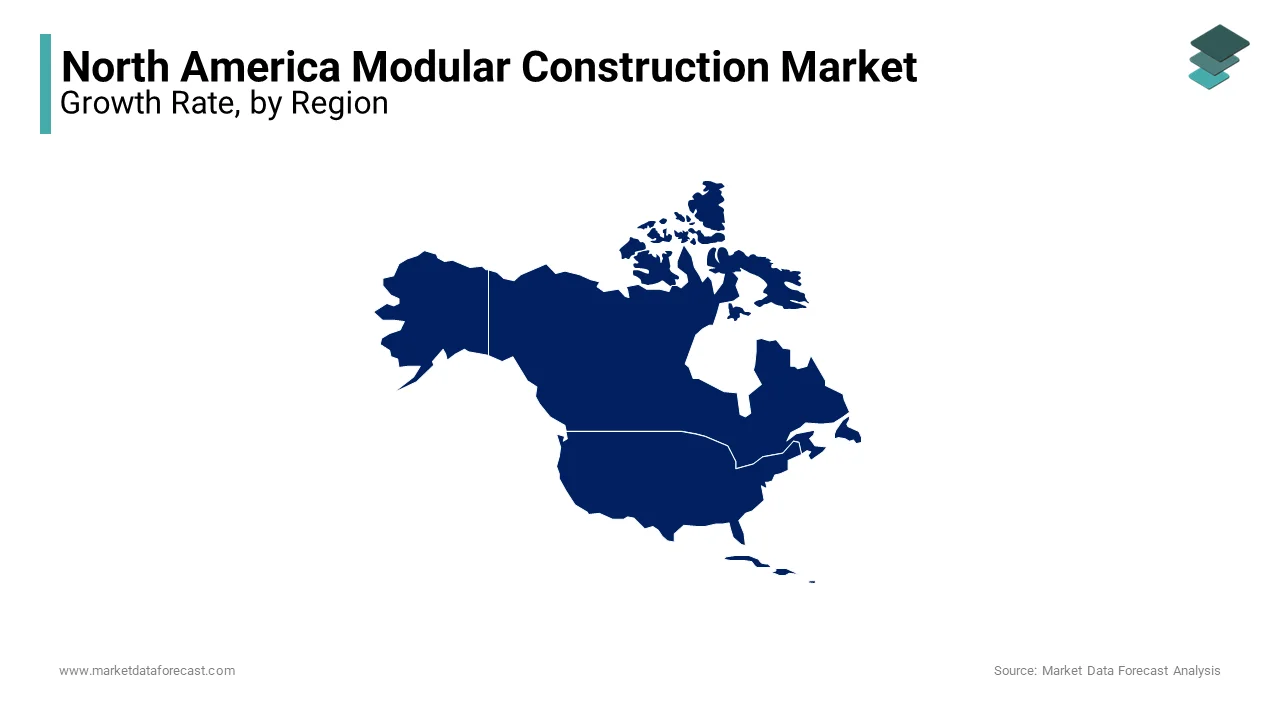North America Modular Construction Market Size, Share, Trends & Growth Forecast Report Segmented By Type, Sector, And By Country (US, Canada, Mexico, and Brazil), Industry Analysis From 2025 to 2033
North American Modular Construction Market Size
The North America modular construction market was valued at USD 38.21 billion in 2024 and is anticipated to reach USD 38.94 billion in 2025 from USD 56.06 billion by 2033, growing at a CAGR of 4.66% during the forecast period from 2025 to 2033.

The modular construction is an innovative approach that allows for significant time and cost savings, as well as enhanced quality control in construction field. It also encompasses a variety of building types, including residential, commercial, and industrial structures, and is increasingly recognized for its sustainability benefits, such as reduced waste and energy efficiency. This growth is driven by several factors, including the rising demand for affordable housing, the need for rapid construction solutions, and the increasing focus on sustainability in the building sector. The market is expected to witness significant advancements in technology and design that further enhance the appeal of modular construction. The ongoing shift towards more efficient and environmentally friendly building practices positions the North American modular construction market for substantial growth in the coming years.
MARKET DRIVERS
Demand for Affordable Housing Solutions
The North American modular construction market is significantly driven by the growing demand for affordable housing solutions. As housing prices continue to rise in many urban areas, the need for cost-effective construction methods has become increasingly urgent. According to the National Association of Home Builders, the average price of a new single-family home in the U.S. reached approximately $400,000 in 2021 by making homeownership unattainable for many individuals and families. Modular construction offers a viable solution by reducing construction time and costs, thereby making housing more accessible.
Modular homes can be built in a fraction of the time compared to traditional construction methods, often within a few months. This accelerated timeline not only helps to meet the urgent demand for housing but also reduces labor costs and minimizes material waste. Additionally, modular construction can be tailored to meet specific community needs by allowing for the development of affordable housing projects that align with local requirements. The modular construction market is expected to experience significant growth with growing need for innovative and efficient building solutions.
Focus on Sustainability and Environmental Impact
The increasing focus on sustainability and reducing the environmental impact of construction activities are escalating the growth of the North America modular construction market. Both consumers and businesses are seeking more sustainable building practices as concerns about climate change and resource depletion grow. According to a report by the World Green Building Council, buildings account for approximately 39% of global carbon emissions with the urgent need for more environmentally friendly construction methods.
Modular construction is inherently more sustainable than traditional building methods, as it typically results in less waste and more efficient use of materials. The controlled factory environment allows for precise manufacturing, reducing the likelihood of errors and excess materials. Additionally, modular buildings can be designed to incorporate energy-efficient features, such as improved insulation and renewable energy systems that further enhances their sustainability profile. The demand for modular construction solutions is expected to grow by positioning the North American modular construction market for continued expansion.
MARKET RESTRAINTS
Perception and Acceptance Challenges
One of the primary restraints affecting the North American modular construction market is the perception and acceptance challenges associated with modular building methods. Despite the numerous benefits of modular construction, including cost savings and reduced construction time, there remains a degree of skepticism among consumers, builders, and investors regarding the quality and durability of modular structures. According to a survey conducted by the Modular Building Institute, 40% of respondents expressed concerns about the perceived quality of modular buildings compared to traditional construction.
This skepticism can hinder the widespread adoption of modular construction, as potential buyers may be hesitant to invest in what they perceive as inferior products. Additionally, misconceptions about modular construction being limited to temporary or low-quality structures can further impede market growth. The industry stakeholders must focus on educating consumers and promoting the advantages of modular construction, including its sustainability, efficiency, and design flexibility. The modular construction market can enhance its credibility and attract a broader audience by addressing these perception issues.
Regulatory and Compliance Hurdles
Another significant challenge facing the North American modular construction market is the regulatory and compliance hurdles that can complicate the approval and permitting processes. Modular construction often involves navigating a complex landscape of building codes, zoning regulations, and safety standards that can vary significantly by region. According to a report by the National Institute of Building Sciences, approximately 30% of construction projects experience delays due to regulatory issues, which can be particularly pronounced in modular construction.
These regulatory challenges can lead to increased costs and extended timelines, undermining some of the key advantages of modular construction. Additionally, the lack of standardized regulations for modular buildings can create uncertainty for manufacturers and developers by making it difficult to ensure compliance across different jurisdictions. Industry stakeholders must advocate for clearer regulations and streamlined approval processes that facilitate the adoption of modular construction.
MARKET OPPORTUNITIES
Technological Advancements in Construction
The North American modular construction market presents significant opportunities for growth through technological advancements in construction methods and materials. Innovations such as Building Information Modeling (BIM), 3D printing, and advanced prefabrication techniques are revolutionizing the way modular buildings are designed and constructed. According to a report by McKinsey, the construction industry could see productivity gains of up to 15% through the adoption of advanced technologies with the potential for increased efficiency in modular construction.
These technological advancements enable manufacturers to create more complex and customized modular designs while reducing waste and construction time. For instance, BIM allows for precise planning and visualization of modular components is facilitating better collaboration among stakeholders and minimizing errors during construction. Additionally, the integration of smart technologies into modular buildings can enhance energy efficiency and occupant comfort. The demand for technologically advanced modular solutions is expected to grow by creating lucrative opportunities for market participants.
Expansion of Infrastructure Projects
Another promising opportunity within the North American modular construction market lies in the expansion of infrastructure projects. The modular construction offers a viable solution for meeting the growing demand for efficient and cost-effective building methods as governments and private entities increasingly invest in infrastructure development. According to the American Society of Civil Engineers, the U.S. will need to invest approximately $4.5 trillion in infrastructure by 2025 to maintain and improve its systems.
Modular construction can significantly reduce the time required to complete infrastructure projects, such as schools, hospitals, and transportation facilities, while also minimizing disruptions to surrounding communities. The ability to prefabricate components off-site allows for faster assembly on-site, enabling projects to be completed more quickly and efficiently. The demand for modular construction solutions that can meet these needs is expected to grow significantly.
REPORT COVERAGE
|
REPORT METRIC |
DETAILS |
|
Market Size Available |
2024 to 2033 |
|
Base Year |
2024 |
|
Forecast Period |
2025 to 2033 |
|
CAGR |
4.66% |
|
Segments Covered |
By Type, Sector And By Country |
|
Various Analyses Covered |
Global, Regional & Country Level Analysis, Segment-Level Analysis, DROC, PESTLE Analysis, Porter’s Five Forces Analysis, Competitive Landscape, Analyst Overview on Investment Opportunities |
|
Regions Covered |
United States, Canada, Mexico, Rest of North America |
|
Market Leaders Profiled |
ATCO Ltd, Katerra Inc, Mobile Modular Management Corporation, Boxx Modular (Black Diamond Group), Aries Building Systems. |
SEGMENTAL ANALYSIS
By Type Insights
The permanent modular construction segment was the largest by capturing 60.1% of the North American modular construction market share in 2024. This dominance can be attributed to the increasing demand for durable and long-lasting structures that can be used for various applications, including residential, commercial, and institutional buildings. Permanent modular construction involves the off-site fabrication of building modules that are then transported and assembled on-site. This method allows for greater control over construction quality and reduces the impact of weather-related delays. Additionally, permanent modular buildings can be designed to meet local building codes and standards by ensuring compliance and durability. The permanent modular construction segment is expected to maintain its leading position in the North American modular construction market.

The relocatable modular construction is projected to experience a CAGR of 30.4% from 2025 to 2033. This growth is driven by the increasing need for flexible and temporary building solutions in various sectors, including education, healthcare, and disaster relief. Relocatable modular construction offers organizations the ability to quickly deploy temporary facilities that can be easily moved or reconfigured as needs change. This flexibility is particularly valuable in situations such as emergency response, where rapid deployment of healthcare facilities or housing is essential. Additionally, relocatable modular buildings can be designed for multiple uses by making them an attractive option for organizations seeking cost-effective and versatile solutions.
By Sector Insights
The residential segment was the largest and held 55.4% of the North American modular construction market share in 2024. This dominance can be attributed to the increasing demand for affordable housing solutions and the growing popularity of modular homes among consumers. Modular homes offer several advantages, including reduced construction time, lower costs, and enhanced energy efficiency. The ability to customize designs and incorporate sustainable materials further appeals to environmentally conscious consumers. Additionally, the growing awareness of the benefits of modular construction, such as reduced waste and improved quality control, is driving demand in the residential sector. The demand for modular residential construction is expected to remain strong as the housing market continues to evolve and the need for affordable housing solutions persists.
The commercial segment is projected to experience a CAGR of 25.3% from 2025 to 2033. This growth is driven by the increasing recognition of the benefits of modular construction in commercial applications, including offices, retail spaces, and hospitality. Modular construction offers commercial developers the ability to complete projects more quickly and cost-effectively by allowing for faster time-to-market. The flexibility to adapt designs to meet specific business needs and the potential for sustainable building practices further enhance the appeal of modular solutions in the commercial sector. The demand for modular construction in commercial applications is expected to grow significantly with the rapid expansion in the North American market.
COUNTRY ANALYSIS
The United States dominated the North American modular construction market with a share of 70.4% in 2024. The U.S. market is characterized by a robust demand for modular construction solutions driven by advancements in technology and the increasing adoption of off-site construction methods across various sectors. According to the U.S. Census Bureau, the number of modular homes built in the U.S. has increased significantly by reflecting a growing preference for efficient building practices. The presence of major modular construction companies and a well-established supply chain further contribute to the country's dominant position in the market. Additionally, the growing emphasis on sustainability and the need for affordable housing solutions are driving investments in modular construction across residential and commercial sectors. The modular construction market is expected to maintain its growth trajectory with technological advancements and evolving consumer preferences.

Canada's modular construction market is likely to experience a fastest CAGR 15.4% during the forecast period. The Canadian modular construction market is influenced by the country's diverse construction landscape, which includes residential, commercial, and institutional projects. According to Statistics Canada, the adoption of modular construction methods is increasing which was driven by the need for efficient and sustainable building solutions. The Canadian government has implemented various initiatives aimed at promoting green building practices and enhancing construction efficiency will further drive the adoption of modular construction technologies. Additionally, the growing focus on affordable housing and urban development is leading to increased investments in modular solutions within the Canadian market. The emphasis on innovation and sustainability is expected to drive further growth in the Canadian modular construction sector.
KEY MARKET PLAYERS
ATCO Ltd, Katerra Inc, Mobile Modular Management Corporation, Boxx Modular (Black Diamond Group), Aries Building Systems. are the some of the market players that are dominating the North America modular construction market.
MARKET SEGMENTATION
This research report on the North American modular construction market is segmented and sub-segmented into the following categories.
By Type Insights
- Permanent
- Relocatable
By Sector Insights
- Residential Segment
- Commercial Segment
By Country
- North America
- U.S.
- Canada
- Mexico
Frequently Asked Questions
What factors are fueling the growth of modular construction in North America?
Rising demand for affordable housing, labor shortages in traditional construction, faster project completion, and sustainability concerns.
How does modular construction differ from conventional building methods?
Modular construction involves prefabricating building sections off-site in a controlled environment, reducing waste, cost, and construction time.
Which sectors are widely adopting modular construction in North America?
Residential, commercial, healthcare, education, and hospitality sectors are increasingly using modular solutions for efficiency and scalability.
Where is modular construction witnessing the highest adoption in North America?
The United States and Canada lead the market, with growing demand in urban areas like New York, Texas, California, and Ontario.
Who are the top players shaping the modular construction industry in North America?
Key companies include Guerdon Modular Buildings, Katerra, Skender, Fleetwood Homes, and NRB Modular Solutions, known for innovative prefab solutions.
Related Reports
Access the study in MULTIPLE FORMATS
Purchase options starting from $ 2000
Didn’t find what you’re looking for?
TALK TO OUR ANALYST TEAM
Need something within your budget?
NO WORRIES! WE GOT YOU COVERED!
Call us on: +1 888 702 9696 (U.S Toll Free)
Write to us: [email protected]